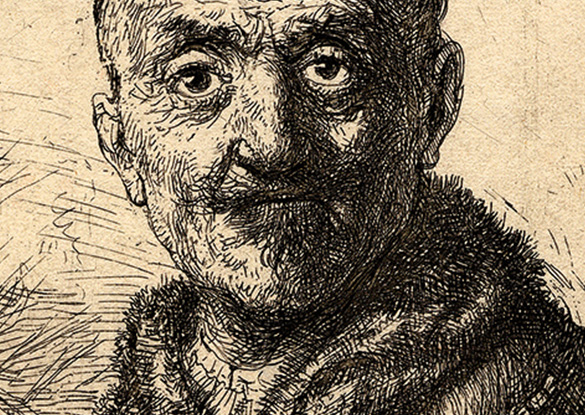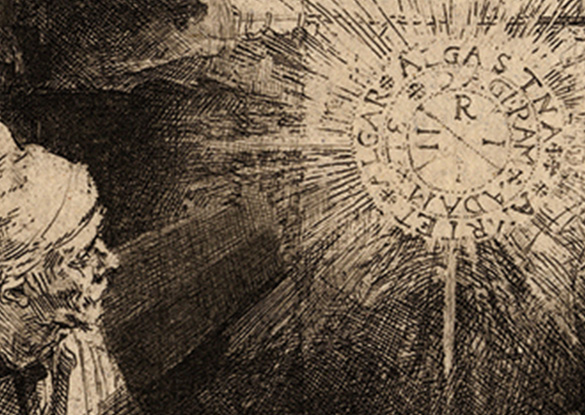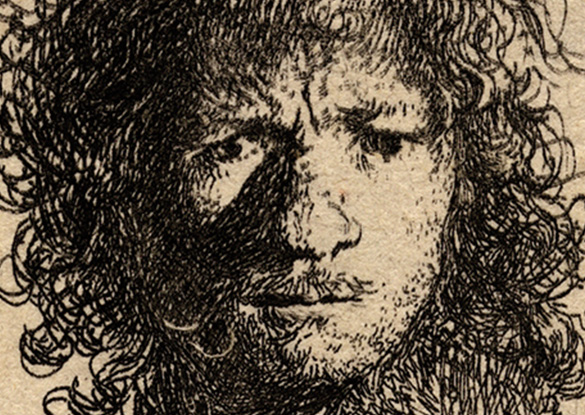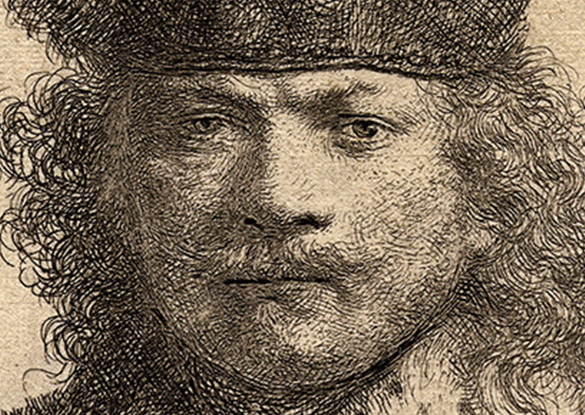EXPOSITION DE PRESTIGE
Les Résonances du réel
Rembrandt (1606-1669)
Singulier, intemporel, universel, l’œuvre gravé de Rembrandt, trois cents estampes environ, réalisées de 1628, première gravure datée, à 1665, fascine et déroute tout à la fois. Quand on croit le saisir, il se dérobe.
Après tant d’autres, Picasso affirme la modernité du maître en 1934 : « C’est encore cette histoire de vernis qui saute… J’ai commencé à griffonner. C’est devenu Rembrandt… Je suis en train de continuer cette planche pour avoir des noirs comme lui… ». Oeuvre aux ressources inépuisables où la technique n’est pas seulement un exploit, mais participe au sens profond de la représentation, en est indissociable. Rembrandt adapte toujours sa manière à ses créations.
Pour faire vibrer ses premiers autoportraits, véritables instantanés, il use de tailles d’eau-forte libres et désordonnées, de zigzags, de zébrures, de vrilles, de points, de plans désorganisés parfois jusqu’à la caricature. Coléreux, facétieux, satisfait, suffisant même, il se découvre avec curiosité. Puis, artiste confirmé, il se livre à une autoanalyse sincère
dans un autoportrait en clair-obscur, Rembrandt gravant ou dessinant près d’une fenêtre, obtenu par l’effleurement d’une lumière filtrant entre les tailles d’eau-forte, pointe sèche et burin, sans recours à la manière noire.
Toujours à la recherche de ce lien entre l’extérieur et l’intérieur de l’être, le visage de « L’Autre »
le captive. Visages de vieillards sculptés par
l’expérience du temps, empreints de sagesse, de résignation, de désarroi, concentrés sur leur vie intérieure, visages sans affection, de ses amis, marchand d’estampes, rabbin, prêtre, ou visages d’anonymes parfois étranges.
Cette quête exigeante des expressions, il la poursuit jusque dans l’attitude de ses personnages, suggérant par une gestuelle très significative, un dialogue, un drame même. Obscénité dérangeante d’un corps offert et repoussé, frayeur d’un nu à la chair flasque surpris dans son bain, réaliste jusqu’à la dérision, désir impérieux et vil d’un homme pour un jeune corps endormi, et plus psychologique l’hésitation face au choix décisif d’un couple de sauvages, celui du commencement du monde. C’est avec une lumière plongeante, violente, contrastée ou envahissante, qu’il accentue symboliquement
la signification de ces thèmes, allant même
parfois plus loin. Ainsi en est-il, lorsqu’il situe Faust dans un clair-obscur troublé par un jeu de lumières propice à une vision, la clarté surnaturelle
d’une apparition superposée à la lumière naturelle d’une fenêtre et contrariée par le vif éclairage, au premier plan, d’une source incertaine.
Sa manière d’œuvrer, il la révèle dans son ultime gravure, L’artiste dessinant d’après le modèle.
Inachevée ?... ou comme il l’affirmait « Une œuvre
est achevée quand un artiste a dit ce qu’il avait
à dire. »
Conservatrice des Estampes de la Bibliothèque Nationale de France
Professeur d'histoire de la gravure à l'école du Louvre
The resonances of truth, what is real
Rembrandt (1606-1669)
Singular, intemporal, universal, the engraving work of Rembrandt which counts for about 300 engravings achieved from the first engraving dated 1628 until 1665, fascinates and at the same time disconcerts. When one believes that one has understood that belief slips away.
After so many others, Picasso in 1934 affirmed the modernity of the Master: « It is still this history of veneer which reappers… I have begun to quickly sketch; it has become a Rembrandt… I am in the process of continuing this plate in order to have black colours like he had ». To work with inexhaustible resources where the technique is not just an exploit or an achievement, but which also participates profoundly in its representation and from which it cannot be dissociated. Rembrandt always adapts his style to his creations.
In order to fill people with enthusiasm towards his first self-portraits, which were genuinely instantaneous, he made use of etching, free and disorderly, of zigzags, streaks, spirals, dots, of disorganised forms almost as far as being caricature. The quick tempered, the facetious, the satisfied, even the self-important, he discovered himself with curiosity. Then as a confirmed artist he surrendered to a sincere autoanalysis in a self-portrait of light and shade. Rembrandt etching or drawing close to a window obtained by the delicate touch of lightfiltering between etching, dry point technique, burin without recourse to blackness.
Always searching for the link between the interior
and the exterior of the being, the face of the
« Other » captivated him. The faces of the elderly sculptured by the experience of life, marked with wisdom, with resignation, with confusion, concentrated on their interior life, faces without affection, of his friends, art dealers, rabbi, priest or anonymous, sometimes strange faces.
This exigent quest of expressions he searched out even in the attitude of his characters by a significant gesture, a dialogue, even a drama. The disturbing obscenity of a body offered and then rejected, the fright of a nude with flaccid flesh surprised in the bath, realist up to derision, the unworthy imperious
desire of a man for a sleeping young body, and more psychological – the hesitation before a decisive
choice of an unrestrained couple, that of the
beginning of the world. It is with a plunging, violent and contrasting or intrusive light which symbolically accentuates the signification of these themes, sometimes even going much further. Thus it is that when he situates Faust in chiaroscuro troubled by a play of light favourable to a vision, the supernatural clarity of an apparition superimposed on the natural light from a window and disturbed by vivid lighting in the foreground from an undefined source.
His manner of working is revealed in his ultimate engraving, The artist drawing according to the model. Unfinished?... or as he affirmed, “a work is finished when an artist has said what he had to say”.
Conservatrice des Estampes de la Bibliothèque Nationale de France
Professeur d'histoire de la gravure à l'école du Louvre
- Présenté à Chamalières du 25/09 au 7/11 2021
Galerie Municipale d’Art Contemproain GMAC
Ouverture : du mardi au dimanche de 14h à 18h.








